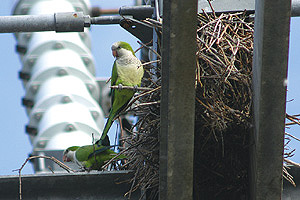Alien invaders: Chicago researcher looks to local citizens for help
By Katie BrandtMedical Center Communications
 Monk parakeets build nests that can be 10-feet wide. Commonwealth Edison workers removed a nest of that size from a utility pole back in 1997. These parakeets typically build their nests out of sticks. | |
Alien invaders exist in Chicago; it’s a proven fact. They are little and green, and for the past four decades they have surveyed human life in the city from on high.
Now, though, one University scientist wants to turn the tables. Stephen Pruett-Jones, Associate Professor in Ecology & Evolution and the College is initiating a yearlong Chicago-area survey, encouraging locals to turn their eyes to the skies in search of these foreign creatures, aka—in this case—monk parakeets, native to the tropics.
Pruett-Jones and research partner Christopher Appelt at Saint Xavier University want to generate a map of all active monk parakeet nests stretching from Northwest Indiana into southern Wisconsin.
Hyde Park residents first reported sightings of the alien species—indigenous to Central and South America—in the late 1960s. Though people kept and continue to keep the parakeets as pets, these sightings were of feral parakeets perched in treetops or on massive nests made primarily of sticks.
 Two monk parakeets add sticks to their nest.  | |
Researchers believe the original feral parakeets in Hyde Park were pets that had escaped their owners. In the wilds of this South Side Chicago neighborhood, they formed colonies, and by the 1990s their population had expanded to an estimated 400 birds.
Now they are expanding again—only this time geographically. During the past eight years, “their numbers in Hyde Park have declined, whereas in surrounding communities their numbers have skyrocketed,” Pruett-Jones said.
“This work will help us better understand the biology of this interesting species and the reasons for its moving out of the city as well as nest site preferences,” he said.
After an initial study, Pruett-Jones concluded that the parakeets were moving away from the city via corridors along train lines and utility structures. They also have switched their dwellings from oak and elm trees to conifers and utility poles, which prove hazardous because “when the nests get wet during rain and snow storms they can cause electrical shorts, power outages and electrical fires.”
Those hazards are no shock to Hyde Park residents who watched workers from the electrical power supplier ComEd remove a 10-foot wide nest from a utility pole in 1997. A debate erupted between the alien species’ advocates and residents who feared for their safety and property values.
“Understanding the present distribution of nests and how corridors of open space facilitate a change in that distribution may help minimize this danger,” Pruett-Jones said.
People who spot the feral green-and-gray creatures and know locations of active nests should send a description of the nests’ exact locations and any other information regarding the parakeets to the researchers at: pruett-jones@uchicago.edu and appelt@sxu.edu, or call (773) 702-3115.
![[Chronicle]](/images/sidebar_header_oct06.gif)